Immunosuppressant Decision Tool
Which Immunosuppressant Is Best for Your Patient?
Answer these clinical questions to determine the most appropriate immunosuppressant.
When doctors need to keep a transplanted organ from being rejected, they often reach for Cyclosporine a calcineurin inhibitor that suppresses T‑cell activation, widely used in kidney, liver and heart transplants as well as in certain autoimmune diseases. While it’s a workhorse, its side‑effect profile and drug‑interaction potential push many clinicians to ask: what are the viable Cyclosporine alternatives and when do they make more sense?
What makes Cyclosporine a go‑to drug?
Cyclosporine works by binding to cyclophilin, blocking calcineurin, and preventing the release of interleukin‑2. This stops the cascade that would normally activate cytotoxic T‑cells. Because of its rapid onset (usually within 24‑48 hours) and proven track record, it became the benchmark immunosuppressant after its approval in the early 1980s.
Typical indications include:
- Kidney, liver, heart, and lung transplantation
- Severe psoriasis
- Rheumatoid arthritis (when other DMARDs fail)
However, patients often face nephrotoxicity, hypertension, gum hyperplasia, and a need for regular therapeutic drug monitoring (TDM). These drawbacks spark the search for alternatives.
Why look for alternatives?
Three main reasons drive a switch:
- Safety concerns: Chronic kidney damage or severe hypertension can limit long‑term use.
- Drug interactions: Cyclosporine is metabolized by CYP3A4, so many antibiotics, antifungals, and statins raise its levels dramatically.
- Patient‑specific response: Some individuals simply don’t achieve therapeutic levels despite high dosing, necessitating a different mechanism of action.
When any of these hit, clinicians evaluate the next best agents.
Top alternatives at a glance
Below are the most frequently considered replacements, each introduced with its own microdata snippet for clarity.
Tacrolimus another calcineurin inhibitor, slightly more potent than Cyclosporine, often preferred for its lower incidence of gum overgrowth is the first pick for many transplant protocols.
Mycophenolate mofetil an antimetabolite that blocks lymphocyte proliferation by inhibiting inosine monophosphate dehydrogenase works well in combination regimens and carries a different side‑effect spectrum (mainly gastrointestinal upset).
Azathioprine a purine analog that interferes with DNA synthesis in rapidly dividing cells, including activated lymphocytes is an older option, useful when cost is a concern.
Sirolimus an mTOR inhibitor that blocks cell‑cycle progression, commonly used to limit vascular proliferation and chronic rejection is often added to reduce nephrotoxicity.
Prednisone a glucocorticoid that dampens inflammation and immune response, typically employed in the early post‑transplant period or as a steroid‑sparing adjunct remains a staple for many clinicians despite its own side‑effect profile.

Side‑by‑side comparison
| Drug | Mechanism | Typical Indications | Onset (hrs) | Half‑life (hrs) | Common Side‑effects | Monitoring Needs |
|---|---|---|---|---|---|---|
| Cyclosporine | Calcineurin inhibition | Kidney, liver, heart transplant; severe psoriasis | 24‑48 | 8‑12 | Nephrotoxicity, hypertension, gum hyperplasia | Therapeutic drug monitoring (TDM) + renal labs |
| Tacrolimus | Calcineurin inhibition (more potent) | Kidney & liver transplant, autoimmune skin disease | 12‑24 | 12‑18 | Nephrotoxicity, neurotoxicity, diabetes | TDM + fasting glucose |
| Mycophenolate mofetil | Inhibition of lymphocyte proliferation | Kidney & heart transplant (often combo) | 48‑72 | 16‑18 | GI upset, leukopenia, infections | CBC, liver enzymes |
| Azathioprine | Purine analog; DNA synthesis inhibition | Kidney transplant, IBD, autoimmune hepatitis | 24‑48 | 5‑6 | Bone marrow suppression, hepatotoxicity | CBC, TPMT activity (genetic test) |
| Sirolimus | mTOR inhibition | Kidney transplant (repurposed), coronary stent | 24‑48 | 60‑80 | Hyperlipidemia, delayed wound healing | TDM + lipid panel |
| Prednisone | Glucocorticoid receptor activation | Acute rejection prophylaxis, autoimmune flare | 1‑2 | 3‑5 | Weight gain, glucose intolerance, osteoporosis | Blood glucose, bone density (long‑term) |
How to decide which drug fits your situation
Think of the choice as a simple decision tree:
- Is renal function stable? - If not, prefer tacrolimus or mTOR inhibitors over cyclosporine, which is more nephrotoxic.
- Do you need rapid onset? - Prednisone and tacrolimus act fastest; mycophenolate takes longer.
- Are you on many CYP3A4‑interacting meds? - Mycophenolate or azathioprine avoid that pathway.
- Cost constraints? - Azathioprine and generic cyclosporine are cheapest; sirolimus can be pricey.
- Long‑term side‑effect tolerance? - If diabetes risk is high, steer clear of tacrolimus; if lipid issues matter, avoid sirolimus.
Most transplant centers now use a triple‑therapy backbone: a calcineurin inhibitor (cyclosporine or tacrolimus), an antimetabolite (mycophenolate), and a short course of steroids. This balances efficacy and toxicity.
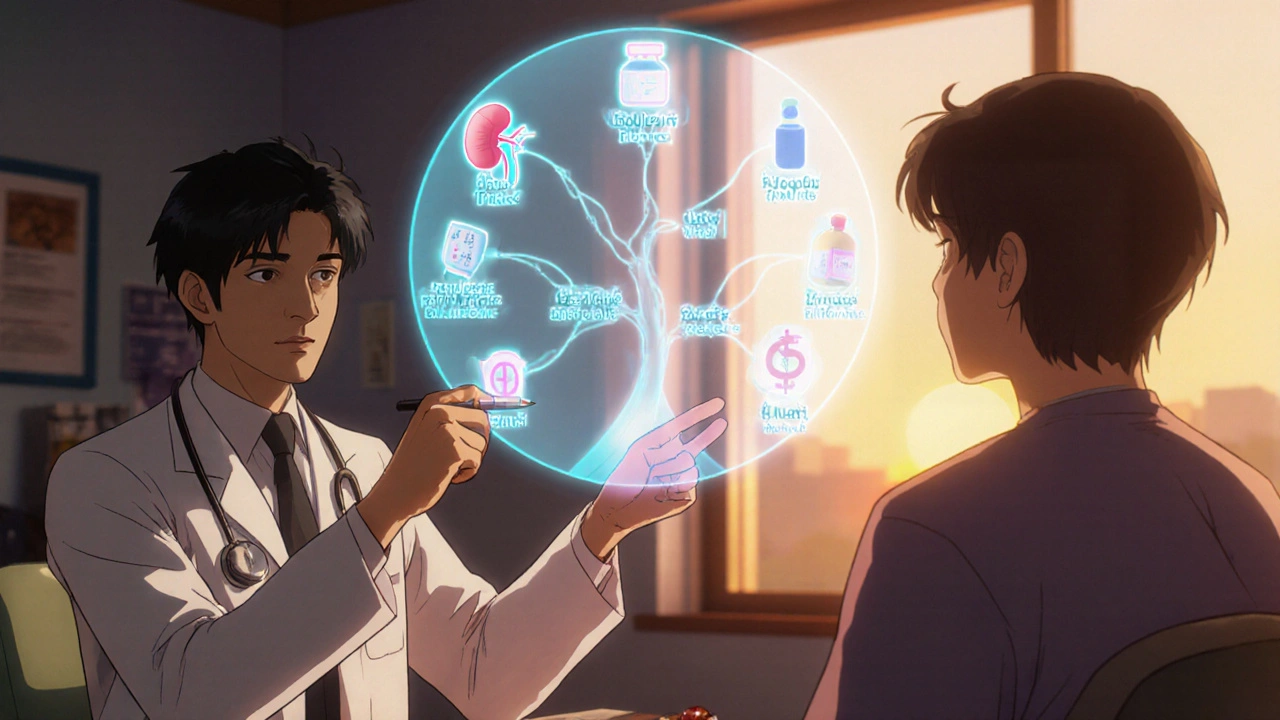
Practical tips for monitoring and dose adjustments
- Therapeutic drug monitoring: Aim for trough levels of 150‑250 ng/mL for cyclosporine in the early phase, 5‑15 ng/mL for tacrolimus.
- Renal labs: Check serum creatinine and eGFR at least weekly for the first month after any dosage change.
- Blood pressure: Hypertension often signals excess calcineurin inhibition; adjust antihypertensives before cutting the immunosuppressant.
- Infection vigilance: Lower white‑blood‑cell counts with mycophenolate or azathioprine call for dose reduction or prophylactic antivirals.
- Patient education: Emphasize consistent dosing times, avoidance of grapefruit juice (CYP3A4 inhibitor), and prompt reporting of new symptoms.
Frequently asked questions
Can I switch from cyclosporine to tacrolimus without a wash‑out period?
Usually yes. Because both drugs share a calcineurin‑inhibition pathway, clinicians overlap them for 24‑48 hours while monitoring trough levels. A brief wash‑out isn’t required, but close lab checks are essential.
Is mycophenolate safer for patients with pre‑existing kidney disease?
Yes. Mycophenolate lacks the nephrotoxic profile of calcineurin inhibitors, making it a favored adjunct when renal function is marginal.
What genetic test helps avoid azathioprine toxicity?
Testing for TPMT (thiopurine methyltransferase) activity predicts how well a patient metabolizes azathioprine. Low activity means higher risk of bone‑marrow suppression.
Why do some doctors add sirolimus to a cyclosporine regimen?
Adding sirolimus can reduce chronic rejection and lower the dose of cyclosporine needed, thereby mitigating nephrotoxicity. The combo is common in kidney transplant protocols after the first six months.
How long should prednisone be continued post‑transplant?
Most centers taper prednisone over 3‑6 months. Some patients stay on a low‑dose maintenance (<5 mg daily) if they have high immunologic risk.
Choosing the right immunosuppressant is rarely a black‑and‑white decision. By weighing organ‑specific risks, drug‑interaction potential, and patient lifestyle, clinicians can tailor a regimen that keeps the graft thriving while minimizing side‑effects.

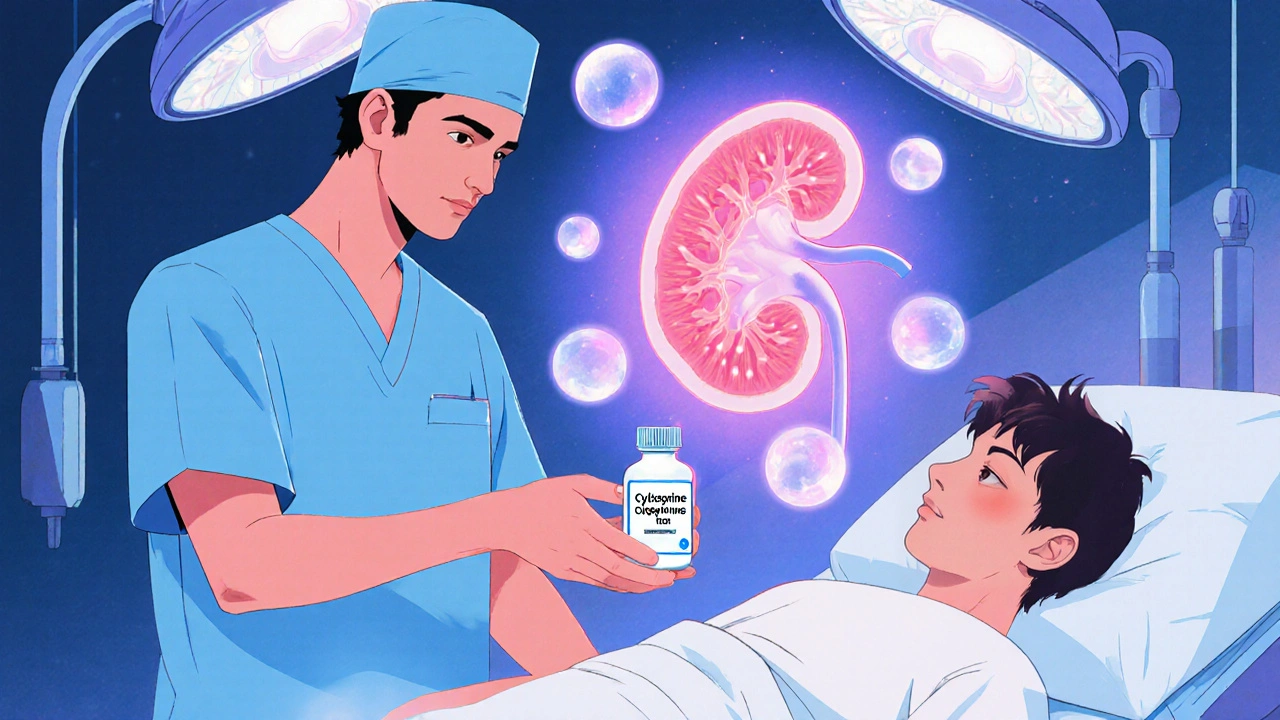

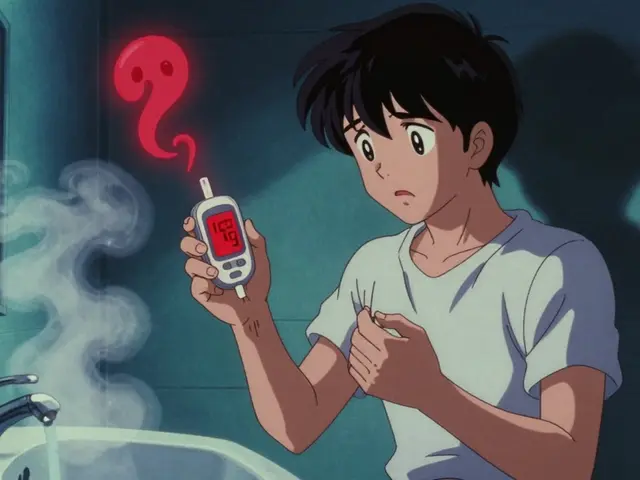
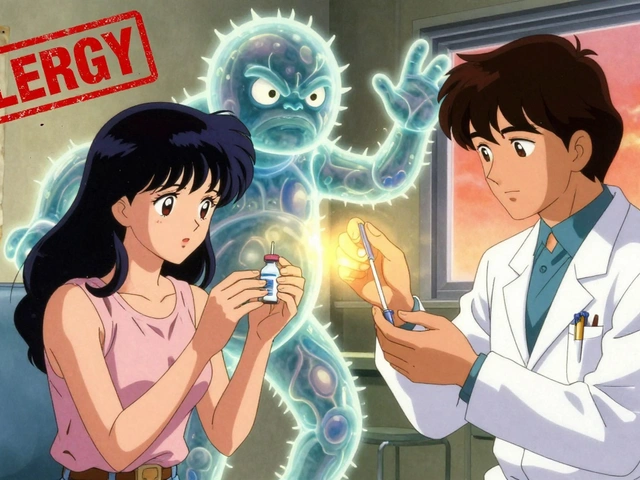
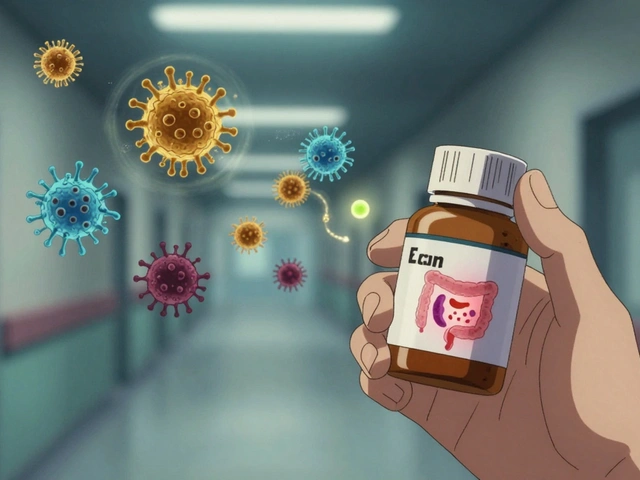
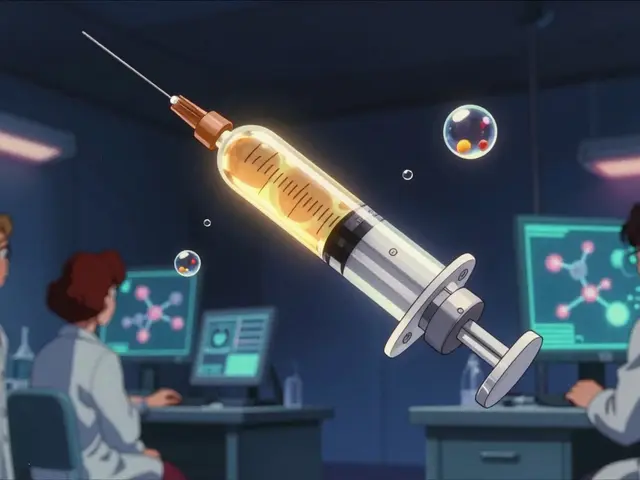
Paul Luxford
October 26, 2025 AT 12:10Cyclosporine has proven its worth over decades, but the risk of nephrotoxicity can't be ignored. It's a balancing act between efficacy and safety.
Manoj Kumar
October 26, 2025 AT 13:00Ah, the grand philosophical debate of immunosuppression: do we cling to the old guard or embrace the shiny new alternatives? In the clinic, the answer often boils down to how much side‑effect baggage we’re willing to carry, and that’s always a delightful exercise in optimism, isn’t it? 😉
Hershel Lilly
October 26, 2025 AT 14:23Tacrolimus is generally considered a bit more potent than cyclosporine, with a quicker onset and less gum overgrowth. Many transplant centers actually start patients on tacrolimus unless there’s a specific contraindication, and the TDM targets are nicely defined.
Laura Hibbard
October 26, 2025 AT 14:40Sure, because nothing says ‘progress’ like swapping one calcineurin inhibitor for another while pretending the side‑effects magically disappear. The sarcasm is optional, but the reality check isn’t.
Rachel Zack
October 26, 2025 AT 15:46I cant beleive doctors still prescibe cyclosporine when there are bettr options.
Lori Brown
October 26, 2025 AT 17:10👍 If the patient’s kidneys are already on the line, mycophenolate is a great go‑to – it sidesteps the classic calcineurin‑inhibitor nephrotoxicity and is pretty well‑tolerated. Stay optimistic! 😊
Jacqui Bryant
October 26, 2025 AT 18:33If you worry about kidneys, try mycophenolate. It works well and doesn’t hurt the kidneys as much.
Brady Johnson
October 26, 2025 AT 18:50Let’s not forget the drama of side‑effects: cyclosporine can turn a steady heart into a ticking time bomb of hypertension, and the gum overgrowth alone could star in a horror flick. The alternative drugs aren’t immune, but the narrative is definitely less terrifying.
Jay Campbell
October 26, 2025 AT 19:56Regular monitoring is key – trough levels, renal function, and blood pressure should all be checked frequently after any dose change. Keeping the lab work tight helps catch problems before they become big issues.
Carla Smalls
October 26, 2025 AT 20:13Exactly, staying on top of those labs really empowers patients to feel in control. It’s a team effort, and the numbers speak louder than guesswork.
Monika Pardon
October 26, 2025 AT 21:20Of course, the secret cabal of pharmaceutical conglomerates would love you to stay glued to cyclosporine forever – after all, why spoil the plot with newer, cheaper alternatives? Yet, the data clearly suggest we have viable options, if we’re willing to read past the marketing fluff.
Rhea Lesandra
October 26, 2025 AT 22:43When choosing an immunosuppressant, the decision tree should start with a clear picture of the patient’s baseline renal function, because that single factor often dictates the entire regimen. If the eGFR is stable and above 60 mL/min, cyclosporine remains an acceptable option, especially when cost constraints are paramount. However, if the kidneys show any sign of strain, tacrolimus or an mTOR inhibitor such as sirolimus can reduce the nephrotoxic load, albeit at the expense of other side‑effects like hyperlipidemia or diabetes risk. Mycophenolate mofetil, being an antimetabolite, sidesteps calcineurin pathways altogether and is especially useful in combination therapy to allow lower calcineurin inhibitor doses. Azathioprine, while older and more affordable, requires TPMT testing to avoid catastrophic bone‑marrow suppression, a step that some centers still bypass for simplicity. Prednisone’s rapid onset makes it indispensable in the immediate post‑transplant period, but long‑term tapering is essential to prevent weight gain, glucose intolerance, and osteoporosis. The art of dosing lies in frequent therapeutic drug monitoring – target trough levels for cyclosporine (150‑250 ng/mL) differ dramatically from those for tacrolimus (5‑15 ng/mL), and overlooking this can lead to silent toxicity. Blood pressure trends should be plotted alongside drug levels, because rising hypertension often signals excessive calcineurin inhibition. Lipid panels become relevant when sirolimus is introduced, as hyperlipidemia can surge within weeks. Infection vigilance is non‑negotiable; both mycophenolate and azathioprine can depress white‑blood‑cell counts, demanding prophylactic antivirals in high‑risk patients. Patient education cannot be overstated – consistent dosing times, avoidance of grapefruit juice, and prompt reporting of new symptoms are the frontline defenses against adverse events. Ultimately, most programs adopt a triple‑therapy backbone: a calcineurin inhibitor, an antimetabolite, and a short course of steroids, tailoring each component to the individual’s comorbidities and financial situation. By regularly revisiting this algorithm, clinicians can keep the balance between graft survival and quality of life firmly in check.